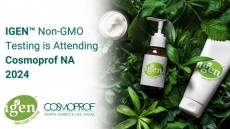Inclusive brands outperform in the beauty market, SeeMe Index reveals

As inclusivity becomes a driving force in consumer behavior, the cosmetics and personal care industry faces increasing pressure to adapt. The SeeMe Index, an AI-driven platform that measures brand inclusivity, provides crucial insights for manufacturers and suppliers seeking to stay competitive in an evolving market. According to Asha Shivaji, CEO and Co-Founder of SeeMe Index, inclusive beauty brands are outpacing their competitors, demonstrating the business benefits of authentic, comprehensive inclusivity strategies.
“Certified Inclusive Brands on the SeeMe Index grew 1.5X faster than less inclusive competitors,” Shivaji explained. This data underscores the importance for brands not only to meet regulatory and consumer expectations for inclusivity but also to integrate inclusivity into their core business strategies. For manufacturers and suppliers, the message is clear: aligning with inclusive brands offers a pathway to increased sales and stronger consumer loyalty.
Shifts in consumer demand: The new normal for industry manufacturers & suppliers
The beauty market is undergoing significant change as inclusivity moves from a niche concern to a mainstream expectation. Younger consumers, in particular, are leading this shift. "45% of Gen Z and 50% of millennials indicate they would stop using a beauty brand if it lacked inclusivity or social responsibility," Shivaji noted.
This has major implications for product development and supplier relationships, as brands must consistently meet a growing demand for inclusivity across product lines and marketing.
This shift is reshaping the supply chain, with manufacturers and suppliers being asked to produce a wider variety of shades, formulations, and products that cater to diverse identities. For instance, brands are expected to offer ranges that accommodate different skin tones, gender expressions, body sizes, and ages.
Companies that fail to do so risk being left behind by an increasingly discerning consumer base.
Shivaji stressed that consumers today can easily detect performative marketing efforts and demand more authentic commitments from brands. “Consumers expect brands to address diverse identities authentically and consistently across every touchpoint,” she said. This includes not just advertising but product development, distribution, and partnerships.
Methodology & measurement: What it means for suppliers
The SeeMe Index provides a roadmap for brands to navigate this new landscape, offering an objective way to measure inclusivity across six identity dimensions: gender expression, age, skin tone, sexual orientation, body size, and visible disability. According to Shivaji, the methodology behind the SeeMe Index evaluates three core aspects: advertisements, product offerings, and external commitments.
For manufacturers and suppliers, these criteria are crucial in understanding where opportunities for improvement lie in their product portfolios.
“The SeeMe Index assesses brands based on consumer-facing components, ensuring that inclusivity is embedded across all areas of a brand’s operations,” said Shivaji. She added that the Index uses objective metrics such as the Monk Skin Tone scale to evaluate inclusivity, ensuring the measurement is both accurate and actionable for companies.
Manufacturers and suppliers can use this information to guide their own product development processes. For example, if a brand is found lacking in skin tone diversity, suppliers might need to develop broader shade ranges or rethink formulations to meet the needs of underrepresented groups.
The business case for inclusivity: A call to action for suppliers
For suppliers and manufacturers, the rise of inclusive branding is not just a moral imperative but a business opportunity. Brands that invest in inclusive products are seeing clear returns. “The growth of Certified Inclusive Brands shows that addressing diverse consumer identities results in stronger brand differentiation, higher consumer loyalty, and increased sales,” Shivaji explained.
The data provided by SeeMe Index highlights that inclusive brands not only perform better but also have a long-term advantage as the U.S. approaches a minority-majority population by 2045. This demographic shift means that what is considered “mass market” will soon reflect a more diverse audience, making inclusive practices a necessity for long-term growth.
Manufacturers and suppliers that align themselves with inclusive brands can expect increased demand for their products as brands seek to expand their offerings to cater to more diverse consumers. Companies that offer innovative solutions for skin tone diversity, body size inclusivity, or age-specific formulations will be well-positioned to secure lucrative partnerships.
Intersectionality and long-term strategy
One of the key insights from the SeeMe Index is the importance of intersectionality—recognizing that consumers embody multiple, overlapping identities. Brands that excel in inclusivity understand that their consumers cannot be viewed through a single lens.
For suppliers, this means developing products that cater to the needs of individuals who may simultaneously represent several identity dimensions.
"Incorporating intersectional thinking requires brands to understand and address the complex interplay of various identity dimensions, such as race, gender, and body size," said Shivaji. Manufacturers and suppliers must consider these factors when developing new products or expanding existing lines.
For instance, formulations that work for a wide range of skin tones should also consider other factors like age and body size to create products that are more inclusive across multiple identities.
Transparency and accountability: Building trust in the supply chain
Another critical takeaway from the SeeMe Index is the growing demand for transparency. “Consumers are increasingly invested in how brands uphold their inclusivity commitments, and they expect measurable, ongoing progress,” Shivaji noted.
For manufacturers and suppliers, this means ensuring that their own processes, from product testing to raw material sourcing, meet the same standards of transparency and accountability.
Suppliers that provide detailed data on product efficacy across diverse consumer groups can help brands build trust and avoid accusations of performative inclusivity. "If a brand commits to identity-specific product testing, it should regularly report how diverse groups are represented in the testing process,” said Shivaji, emphasizing the importance of continuous, detailed communication.
Embracing inclusivity for future growth
As consumer expectations continue to evolve, manufacturers and suppliers in the cosmetics and personal care industry must stay ahead of the curve by prioritizing inclusivity in their product offerings and supply chain practices. The findings from the SeeMe Index make it clear: inclusivity is no longer just a marketing strategy but a key driver of business success.
For companies looking to stay competitive, aligning with the principles of inclusivity offers both social and economic benefits. “Inclusive beauty is not a trend—it’s the future of the industry,” Shivaji concluded. As brands and suppliers work together to meet the demands of a more diverse consumer base, those that embrace inclusivity will be well-positioned for growth in the years to come.

















